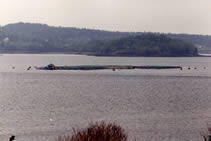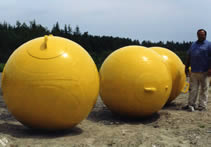The rugged coast of Maine is not the place for the faint-hearted and meek. Travel "downeast" as far as you can go and you'll reach the harbor at Lubec, Maine, the easternmost port in the United States. Here you'll find an innovative fish farm owned by the Atlantic Salmon Company. It is in the hostile waters of Lubec Harbor (as well as in Machias Bay) that the company raises Atlantic salmon, a seafood delicacy.
"Corrals" That Float--and Rust
The floating pens that hold the salmon are reminiscent of a corral used to round up cattle in the wild west. But there is one major difference -- these "corrals" are afloat in a hostile, salt water environment. The forty huge, metal buoys-measuring up to 51/2 feet in diameter-used to support the containing nets are subject to the most corrosive environment imaginable. Despite a regular regimen of repair and repainting, the buoys rusted heavily within two months. Such high maintenance costs could not be allowed to continue.

ZRC to the Rescue
A local contractor, Roy Love of Love's Painting Company, was called in to solve the problem. There was no hesitation on Love's part-he immediately recommended the buoys be coated with ZRC Galvanizing Compound.
Love's Painting sandblasted each of the steel buoys to near white surface condition, then applied ZRC This was followed by a heavy coat of bright yellow epoxy.
The results have been nothing short of remarkable. The buoys -which were once painted every two months-are now entering their third year of successful operation without damage from corrosion. This despite being in an environment of total immersion in pounding salt water.
Because of my experience in the field with this product, I always recommend ZRC in corrosive applications, I've used ZRC to regalvanize radar towers and catwalk gratings for the Navy at the base in Winter Harbor, Maine. I also used it on metal roofs and on salt water cookers at a canning company. In all cases, it has provided five years or more of rust-free protection.
Roy Love | Love's Painting Company

The ZRC Difference
Why does ZRC perform so well under such harsh conditions? Unlike other coatings, ZRC is a 95% liquid zinc organic compound. The galvanic protection of zinc acts as a physical barrier against rust, rust creepage and contaminants. As the zinc content of ZRC is sacrificed to prevent rust from starting, insoluble corrosion by-products are formed. These byproducts fill voids and pores in the zinc primer film, forming an insoluble barrier to further protect against attacks on the zinc film and steel substrate. Many of these by-products also tend to inhibit the rusting process by increasing the pH level.
ZRC continues to provide protection against rust and rust creepage even if the protected surface is scratched to the bare metal. The zinc forms a layer of insoluble zinc salt over the exposed area, "healing" the break and providing protection against corrosion. Due to these properties, ZRC is often specified for applications in highly corrosive environments.
Although they may not realize it, seafood lovers around the world can continue to enjoy the delectable Atlantic salmon, thanks in large part to ZRC.

